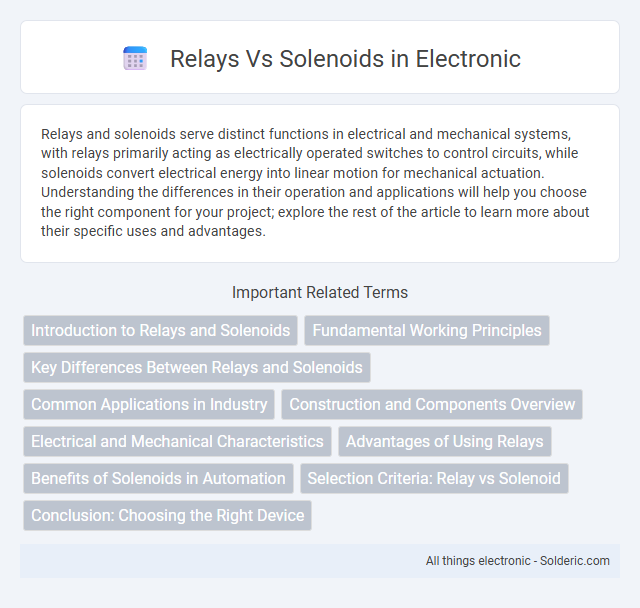Relays and solenoids serve distinct functions in electrical and mechanical systems, with relays primarily acting as electrically operated switches to control circuits, while solenoids convert electrical energy into linear motion for mechanical actuation. Understanding the differences in their operation and applications will help you choose the right component for your project; explore the rest of the article to learn more about their specific uses and advantages.
Comparison Table
| Feature | Relays | Solenoids |
|---|---|---|
| Function | Electrically operated switch | Electromechanical actuator |
| Primary Use | Signal switching and circuit control | Linear motion for mechanical movement |
| Operation | Opens/closes contacts to control electrical circuits | Converts electrical energy to linear mechanical force |
| Current Type | AC and DC compatible | Typically DC powered |
| Response Time | Milliseconds, fast switching | Milliseconds, mechanical delay due to movement |
| Power Consumption | Low to moderate | Higher due to coil and mechanical movement |
| Load Handling | Controls high voltage/current circuits indirectly | Directly performs mechanical tasks |
| Typical Applications | Automotive electronics, industrial controls, home automation | Lock mechanisms, valves, automotive starters |
| Size | Compact, varies by load capacity | Bulkier due to coil and plunger assembly |
| Durability | High cycling life, low mechanical wear | Wear due to moving parts, limited stroke lifespan |
Introduction to Relays and Solenoids
Relays and solenoids are essential electromechanical devices used for controlling circuits and mechanical movements, respectively. A relay operates as an electrically controlled switch, enabling your circuits to manage high-power loads with low-power signals, while a solenoid converts electrical energy into linear mechanical motion for applications like locking mechanisms or valve control. Understanding the distinct functions and design of relays and solenoids is crucial for selecting the right component in automation and control systems.
Fundamental Working Principles
Relays operate by using an electromagnetic coil to mechanically switch electrical contacts, allowing control of high-power circuits with a low-power signal. Solenoids function through an electromagnetic coil that creates linear motion, moving a plunger to perform mechanical tasks such as opening valves or locking mechanisms. Understanding these fundamental working principles helps you select the appropriate device for switching electrical circuits or producing mechanical movement.
Key Differences Between Relays and Solenoids
Relays primarily serve as electrically operated switches that control circuits by opening or closing contacts, whereas solenoids function as electromagnetic actuators converting electrical energy into linear motion. Relays typically handle low-current control signals to switch higher power loads, while solenoids generate mechanical movement used in locking, valve control, or actuating devices. The key difference lies in relays' role in circuit switching versus solenoids' role in producing physical motion.
Common Applications in Industry
Relays are widely used in industrial automation for controlling high-power circuits with low-power signals, often found in motor control, lighting systems, and safety interlocks. Solenoids serve as electromechanical actuators in applications such as valve operation, locking mechanisms, and material handling equipment. Both components play critical roles in manufacturing processes, robotics, and process control systems, offering precise control and automation capabilities.
Construction and Components Overview
Relays consist of an electromagnetic coil, a movable armature, and one or more sets of electrical contacts designed to open or close circuits. Solenoids feature a coil wound around a movable iron core or plunger that creates linear motion when energized. Your choice depends on whether you need primarily electrical switching (relay) or mechanical actuation (solenoid).
Electrical and Mechanical Characteristics
Relays operate as electrical switches using an electromagnetic coil to open or close contacts, enabling control of high-power circuits with low-power signals, offering precise electrical isolation and fast switching capabilities. Solenoids convert electrical energy into linear mechanical motion via a coil and plunger, ideal for applications requiring direct mechanical actuation such as locking or valve operation. Your choice depends on whether you need electrical switching (relay) or mechanical movement (solenoid), considering factors like response time, force, and duty cycle.
Advantages of Using Relays
Relays offer significant advantages such as electrical isolation between control and load circuits, which enhances safety and protects sensitive components. They provide the ability to control high voltage and high current devices with a low power signal, making them ideal for automation and remote control applications. Additionally, relays have a longer lifespan in switching applications due to mechanical durability and resistance to electrical noise compared to solenoids.
Benefits of Solenoids in Automation
Solenoids offer precise and rapid actuation in automation systems, enabling efficient control of mechanical movements with minimal energy consumption. Their compact design and reliable electromagnetic operation make them ideal for repetitive tasks requiring consistent performance. You benefit from enhanced system responsiveness and reduced maintenance compared to traditional relays in automated applications.
Selection Criteria: Relay vs Solenoid
Selecting between relays and solenoids depends on the application's specific electrical and mechanical requirements; relays are preferred for switching electrical circuits with high control precision and fast response times, while solenoids excel in providing linear mechanical motion or actuation. Key criteria include load type, voltage and current ratings, switching speed, mechanical force needed, and duty cycle; relays typically handle higher switching frequencies and complex circuit control, whereas solenoids are chosen for direct mechanical activation and holding power. Environmental factors such as temperature, vibration, and size constraints also influence selection, with sealed solenoids offering durability in harsh conditions and relays suitable for sensitive electrical isolation.
Conclusion: Choosing the Right Device
Relays offer precise electrical switching with low power consumption, ideal for signal control applications, while solenoids provide linear mechanical movement suited for actuating or locking mechanisms. Your choice depends on whether you need electrical isolation and control (relays) or mechanical force and motion (solenoids). Understanding these differences ensures optimal performance and efficiency in your specific application.
relays vs solenoids Infographic

 solderic.com
solderic.com